Case Study: Target Canada's Market Entry and Failure Analysis
VerifiedAdded on 2022/09/18
|10
|1528
|16
Case Study
AI Summary
This case study analyzes the failure of Target Corporation's expansion into the Canadian market, focusing on the key issues that led to its downfall. The analysis begins with a clear statement of the main problem, which is identified as an outdated marketing strategy and a lack of online presence, compounded by issues in supplier relationships and the replication of US marketing strategies without considering Canadian consumer behavior. The case study explores Target Canada's key goals, assessing their reasonableness, and employs both quantitative and qualitative analysis, including a SWOT analysis, to identify the core problems. The quantitative analysis highlights the failure to establish a robust online presence and the significance of online shopping preferences in the Canadian market. The qualitative analysis focuses on strengths, weaknesses, opportunities, and threats (SWOT) faced by the company. The study then proposes solutions, including enhancing the online presence, refining the marketing strategy for stores, and improving supplier relationships, followed by a detailed implementation plan based on Lewin’s change management model. The conclusion emphasizes the importance of adapting strategies to the Canadian market and developing both online and offline presence to achieve a competitive advantage. The assignment includes relevant references and appendices.

11
Running head: Case Study analysis
Case Study: ‘Target Canada’
Running head: Case Study analysis
Case Study: ‘Target Canada’
Paraphrase This Document
Need a fresh take? Get an instant paraphrase of this document with our AI Paraphraser
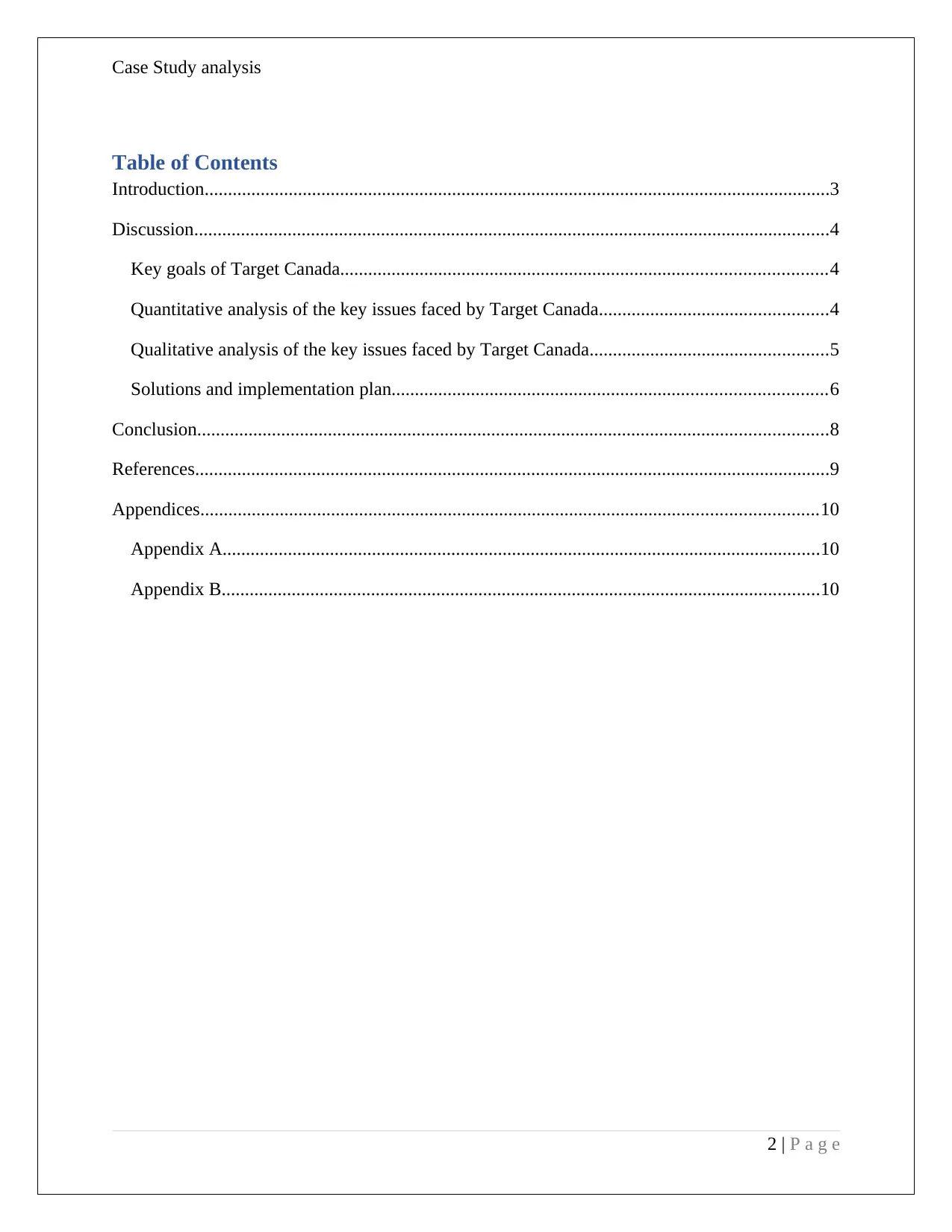
Case Study analysis
Table of Contents
Introduction......................................................................................................................................3
Discussion........................................................................................................................................4
Key goals of Target Canada........................................................................................................4
Quantitative analysis of the key issues faced by Target Canada.................................................4
Qualitative analysis of the key issues faced by Target Canada...................................................5
Solutions and implementation plan.............................................................................................6
Conclusion.......................................................................................................................................8
References........................................................................................................................................9
Appendices....................................................................................................................................10
Appendix A................................................................................................................................10
Appendix B................................................................................................................................10
2 | P a g e
Table of Contents
Introduction......................................................................................................................................3
Discussion........................................................................................................................................4
Key goals of Target Canada........................................................................................................4
Quantitative analysis of the key issues faced by Target Canada.................................................4
Qualitative analysis of the key issues faced by Target Canada...................................................5
Solutions and implementation plan.............................................................................................6
Conclusion.......................................................................................................................................8
References........................................................................................................................................9
Appendices....................................................................................................................................10
Appendix A................................................................................................................................10
Appendix B................................................................................................................................10
2 | P a g e
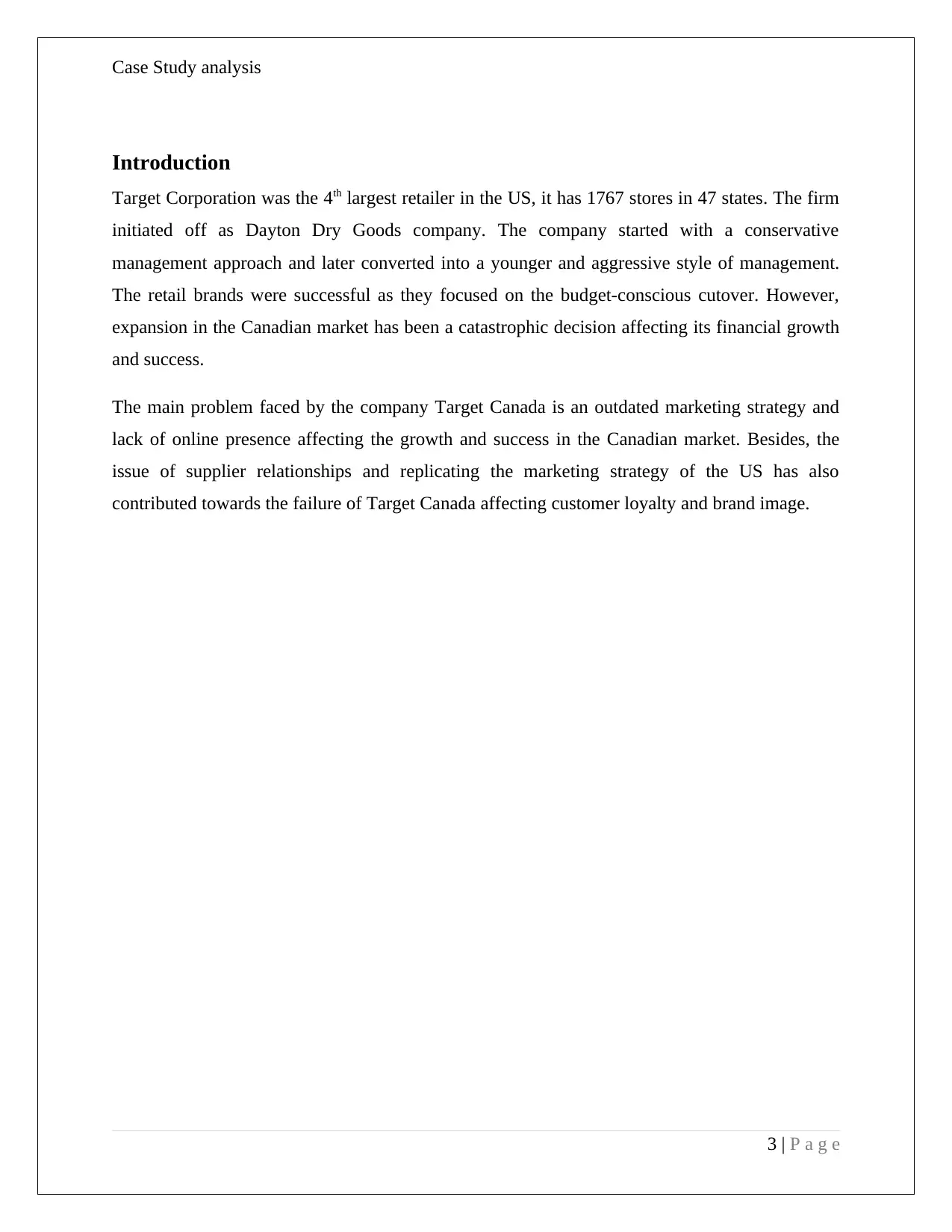
Case Study analysis
Introduction
Target Corporation was the 4th largest retailer in the US, it has 1767 stores in 47 states. The firm
initiated off as Dayton Dry Goods company. The company started with a conservative
management approach and later converted into a younger and aggressive style of management.
The retail brands were successful as they focused on the budget-conscious cutover. However,
expansion in the Canadian market has been a catastrophic decision affecting its financial growth
and success.
The main problem faced by the company Target Canada is an outdated marketing strategy and
lack of online presence affecting the growth and success in the Canadian market. Besides, the
issue of supplier relationships and replicating the marketing strategy of the US has also
contributed towards the failure of Target Canada affecting customer loyalty and brand image.
3 | P a g e
Introduction
Target Corporation was the 4th largest retailer in the US, it has 1767 stores in 47 states. The firm
initiated off as Dayton Dry Goods company. The company started with a conservative
management approach and later converted into a younger and aggressive style of management.
The retail brands were successful as they focused on the budget-conscious cutover. However,
expansion in the Canadian market has been a catastrophic decision affecting its financial growth
and success.
The main problem faced by the company Target Canada is an outdated marketing strategy and
lack of online presence affecting the growth and success in the Canadian market. Besides, the
issue of supplier relationships and replicating the marketing strategy of the US has also
contributed towards the failure of Target Canada affecting customer loyalty and brand image.
3 | P a g e
⊘ This is a preview!⊘
Do you want full access?
Subscribe today to unlock all pages.

Trusted by 1+ million students worldwide

Case Study analysis
Discussion
Key goals of Target Canada
The rapid buyout of retail chain Zeller Inc and convert around 124 of them into Target
stores
This goal is highly unjustified as the huge investment made to renovate and design the stores was
relatively high as going for such huge expansion requires an in-depth analysis of the market,
which was lacking in the case of Target Canada. As stated by Im et al. (2016), international
expansion requires an in-depth understanding of the buying behaviour of customers and
knowledge about demographics that can ensure the success of the company.
To adopt a cost-cutting strategy and reduce supplier interests
As put forwarded by Idowu (2016), expanding into the international market requires huge
investment and innovation. Hence, this goal is unreasonable. This cost-cutting strategy led the
company into declined product innovation, new merchandise availability and designer
relationship.
To focus on particular market segments for better turnover and brand image
This goal is also unreasonable for Target Canada as the company developed a marketing strategy
similar to the United States without considering the buying behaviour and intentions of
customers. This critically led to the failure of the Canadian expansion of Target.
Quantitative analysis of the key issues faced by Target Canada
Failure to develop the online store Target.ca and market it in the Canadian market has been a
major flaw within the business strategy of Target Canada. It has been comprehended that around
10% of operational costs were utilized for IT systems for the stores and online presence. It has
been well stated by Reim et al. (2019), an online presence is highly significant in the present
business world to attain customer base and growth. It has been also comprehended that 20% of
Canadian customer prefers online shopping instead of stores compared to the US which is around
10%. Hence, this is a significant issue (Refer to Appendix A).
4 | P a g e
Discussion
Key goals of Target Canada
The rapid buyout of retail chain Zeller Inc and convert around 124 of them into Target
stores
This goal is highly unjustified as the huge investment made to renovate and design the stores was
relatively high as going for such huge expansion requires an in-depth analysis of the market,
which was lacking in the case of Target Canada. As stated by Im et al. (2016), international
expansion requires an in-depth understanding of the buying behaviour of customers and
knowledge about demographics that can ensure the success of the company.
To adopt a cost-cutting strategy and reduce supplier interests
As put forwarded by Idowu (2016), expanding into the international market requires huge
investment and innovation. Hence, this goal is unreasonable. This cost-cutting strategy led the
company into declined product innovation, new merchandise availability and designer
relationship.
To focus on particular market segments for better turnover and brand image
This goal is also unreasonable for Target Canada as the company developed a marketing strategy
similar to the United States without considering the buying behaviour and intentions of
customers. This critically led to the failure of the Canadian expansion of Target.
Quantitative analysis of the key issues faced by Target Canada
Failure to develop the online store Target.ca and market it in the Canadian market has been a
major flaw within the business strategy of Target Canada. It has been comprehended that around
10% of operational costs were utilized for IT systems for the stores and online presence. It has
been well stated by Reim et al. (2019), an online presence is highly significant in the present
business world to attain customer base and growth. It has been also comprehended that 20% of
Canadian customer prefers online shopping instead of stores compared to the US which is around
10%. Hence, this is a significant issue (Refer to Appendix A).
4 | P a g e
Paraphrase This Document
Need a fresh take? Get an instant paraphrase of this document with our AI Paraphraser
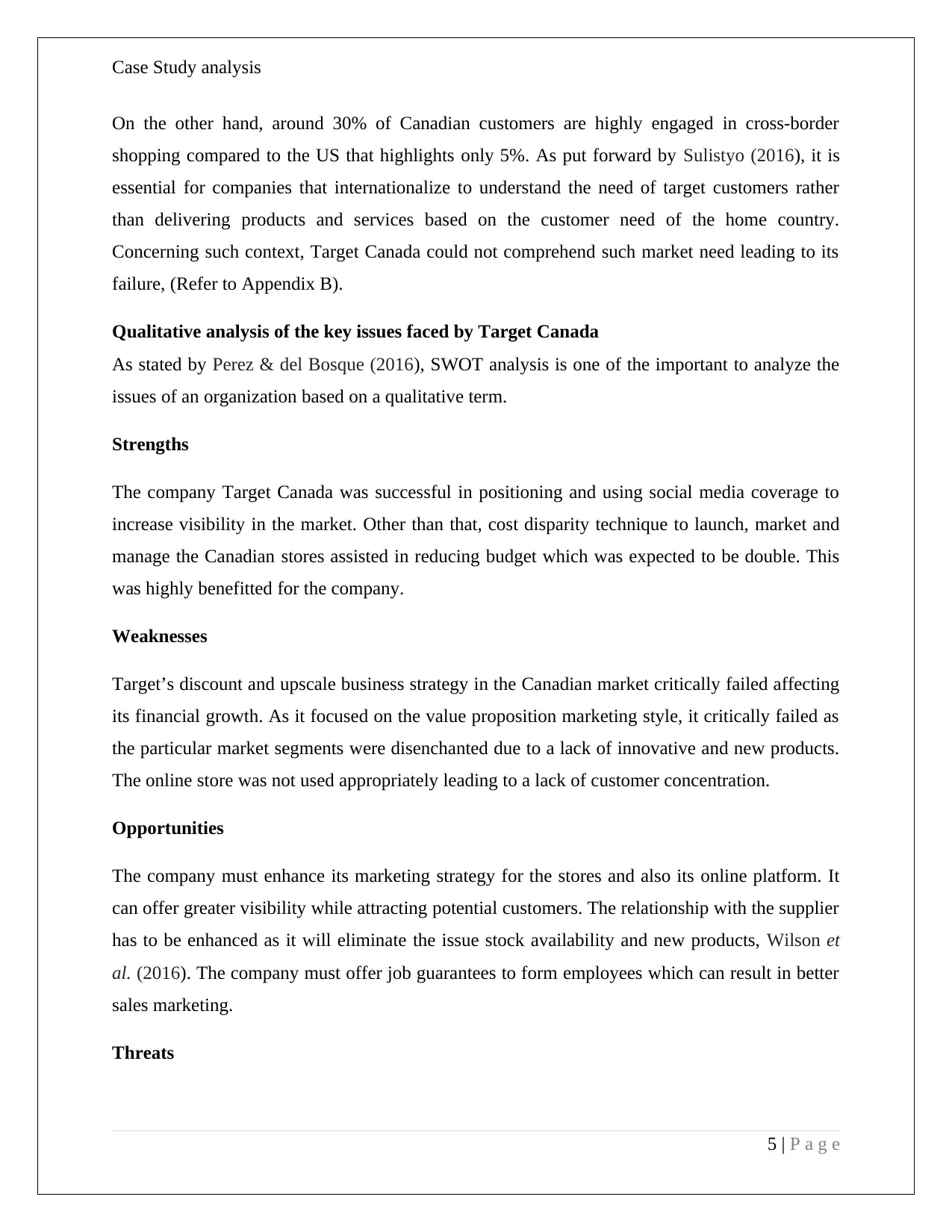
Case Study analysis
On the other hand, around 30% of Canadian customers are highly engaged in cross-border
shopping compared to the US that highlights only 5%. As put forward by Sulistyo (2016), it is
essential for companies that internationalize to understand the need of target customers rather
than delivering products and services based on the customer need of the home country.
Concerning such context, Target Canada could not comprehend such market need leading to its
failure, (Refer to Appendix B).
Qualitative analysis of the key issues faced by Target Canada
As stated by Perez & del Bosque (2016), SWOT analysis is one of the important to analyze the
issues of an organization based on a qualitative term.
Strengths
The company Target Canada was successful in positioning and using social media coverage to
increase visibility in the market. Other than that, cost disparity technique to launch, market and
manage the Canadian stores assisted in reducing budget which was expected to be double. This
was highly benefitted for the company.
Weaknesses
Target’s discount and upscale business strategy in the Canadian market critically failed affecting
its financial growth. As it focused on the value proposition marketing style, it critically failed as
the particular market segments were disenchanted due to a lack of innovative and new products.
The online store was not used appropriately leading to a lack of customer concentration.
Opportunities
The company must enhance its marketing strategy for the stores and also its online platform. It
can offer greater visibility while attracting potential customers. The relationship with the supplier
has to be enhanced as it will eliminate the issue stock availability and new products, Wilson et
al. (2016). The company must offer job guarantees to form employees which can result in better
sales marketing.
Threats
5 | P a g e
On the other hand, around 30% of Canadian customers are highly engaged in cross-border
shopping compared to the US that highlights only 5%. As put forward by Sulistyo (2016), it is
essential for companies that internationalize to understand the need of target customers rather
than delivering products and services based on the customer need of the home country.
Concerning such context, Target Canada could not comprehend such market need leading to its
failure, (Refer to Appendix B).
Qualitative analysis of the key issues faced by Target Canada
As stated by Perez & del Bosque (2016), SWOT analysis is one of the important to analyze the
issues of an organization based on a qualitative term.
Strengths
The company Target Canada was successful in positioning and using social media coverage to
increase visibility in the market. Other than that, cost disparity technique to launch, market and
manage the Canadian stores assisted in reducing budget which was expected to be double. This
was highly benefitted for the company.
Weaknesses
Target’s discount and upscale business strategy in the Canadian market critically failed affecting
its financial growth. As it focused on the value proposition marketing style, it critically failed as
the particular market segments were disenchanted due to a lack of innovative and new products.
The online store was not used appropriately leading to a lack of customer concentration.
Opportunities
The company must enhance its marketing strategy for the stores and also its online platform. It
can offer greater visibility while attracting potential customers. The relationship with the supplier
has to be enhanced as it will eliminate the issue stock availability and new products, Wilson et
al. (2016). The company must offer job guarantees to form employees which can result in better
sales marketing.
Threats
5 | P a g e
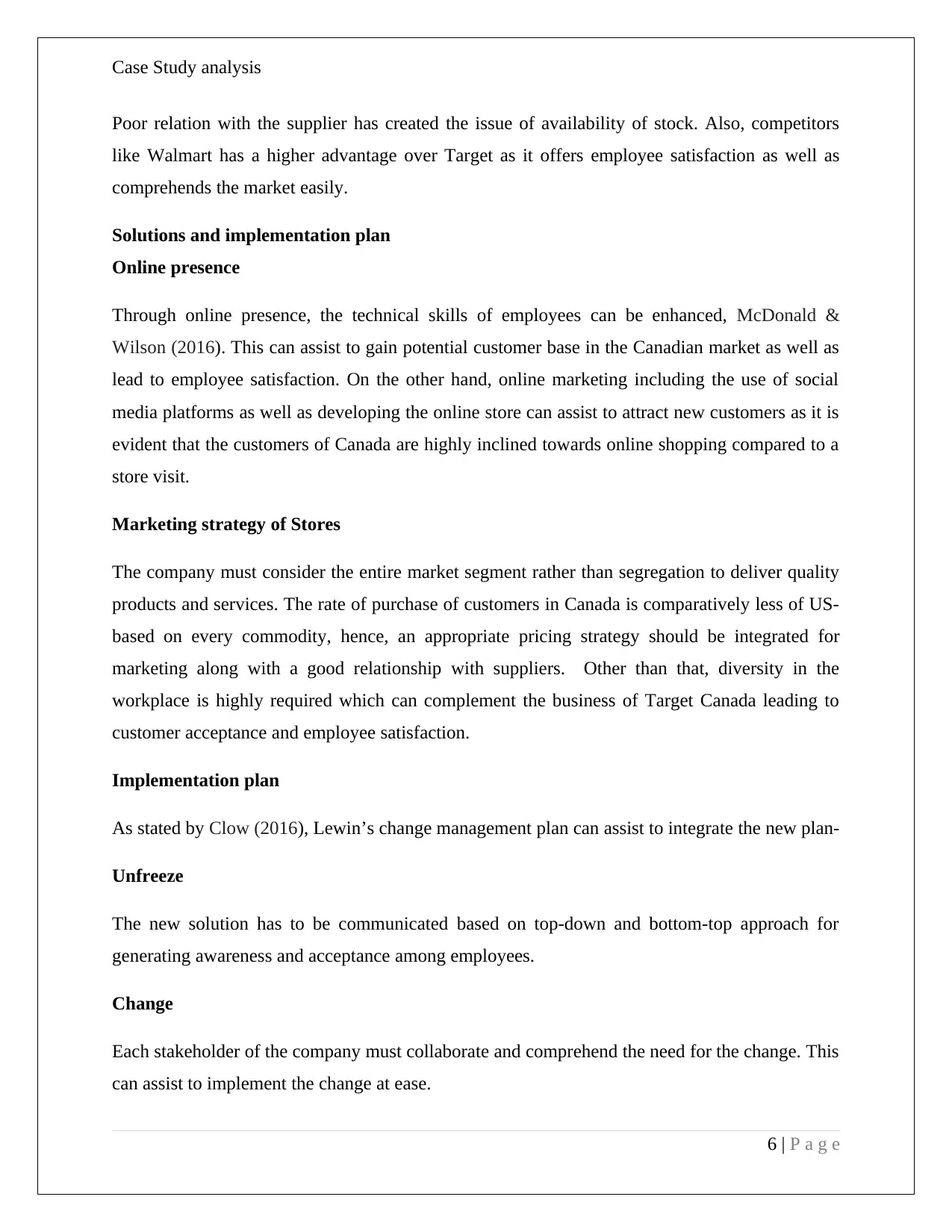
Case Study analysis
Poor relation with the supplier has created the issue of availability of stock. Also, competitors
like Walmart has a higher advantage over Target as it offers employee satisfaction as well as
comprehends the market easily.
Solutions and implementation plan
Online presence
Through online presence, the technical skills of employees can be enhanced, McDonald &
Wilson (2016). This can assist to gain potential customer base in the Canadian market as well as
lead to employee satisfaction. On the other hand, online marketing including the use of social
media platforms as well as developing the online store can assist to attract new customers as it is
evident that the customers of Canada are highly inclined towards online shopping compared to a
store visit.
Marketing strategy of Stores
The company must consider the entire market segment rather than segregation to deliver quality
products and services. The rate of purchase of customers in Canada is comparatively less of US-
based on every commodity, hence, an appropriate pricing strategy should be integrated for
marketing along with a good relationship with suppliers. Other than that, diversity in the
workplace is highly required which can complement the business of Target Canada leading to
customer acceptance and employee satisfaction.
Implementation plan
As stated by Clow (2016), Lewin’s change management plan can assist to integrate the new plan-
Unfreeze
The new solution has to be communicated based on top-down and bottom-top approach for
generating awareness and acceptance among employees.
Change
Each stakeholder of the company must collaborate and comprehend the need for the change. This
can assist to implement the change at ease.
6 | P a g e
Poor relation with the supplier has created the issue of availability of stock. Also, competitors
like Walmart has a higher advantage over Target as it offers employee satisfaction as well as
comprehends the market easily.
Solutions and implementation plan
Online presence
Through online presence, the technical skills of employees can be enhanced, McDonald &
Wilson (2016). This can assist to gain potential customer base in the Canadian market as well as
lead to employee satisfaction. On the other hand, online marketing including the use of social
media platforms as well as developing the online store can assist to attract new customers as it is
evident that the customers of Canada are highly inclined towards online shopping compared to a
store visit.
Marketing strategy of Stores
The company must consider the entire market segment rather than segregation to deliver quality
products and services. The rate of purchase of customers in Canada is comparatively less of US-
based on every commodity, hence, an appropriate pricing strategy should be integrated for
marketing along with a good relationship with suppliers. Other than that, diversity in the
workplace is highly required which can complement the business of Target Canada leading to
customer acceptance and employee satisfaction.
Implementation plan
As stated by Clow (2016), Lewin’s change management plan can assist to integrate the new plan-
Unfreeze
The new solution has to be communicated based on top-down and bottom-top approach for
generating awareness and acceptance among employees.
Change
Each stakeholder of the company must collaborate and comprehend the need for the change. This
can assist to implement the change at ease.
6 | P a g e
⊘ This is a preview!⊘
Do you want full access?
Subscribe today to unlock all pages.

Trusted by 1+ million students worldwide

Case Study analysis
Freeze
After integrating the change, the management must follow the validation of change among
employees and support them as needed. This can assist to make the necessary integration of
online and offline marketing strategy.
7 | P a g e
Freeze
After integrating the change, the management must follow the validation of change among
employees and support them as needed. This can assist to make the necessary integration of
online and offline marketing strategy.
7 | P a g e
Paraphrase This Document
Need a fresh take? Get an instant paraphrase of this document with our AI Paraphraser
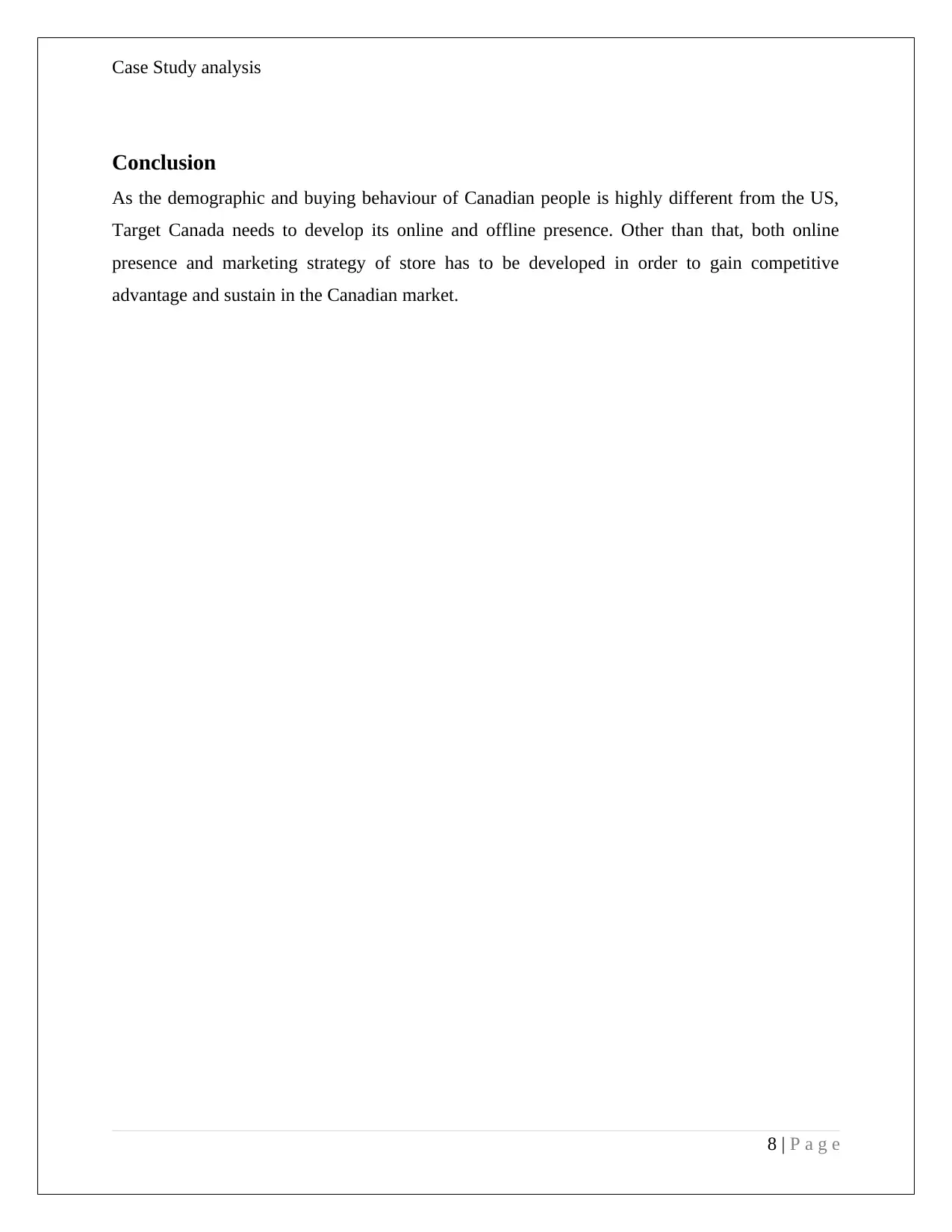
Case Study analysis
Conclusion
As the demographic and buying behaviour of Canadian people is highly different from the US,
Target Canada needs to develop its online and offline presence. Other than that, both online
presence and marketing strategy of store has to be developed in order to gain competitive
advantage and sustain in the Canadian market.
8 | P a g e
Conclusion
As the demographic and buying behaviour of Canadian people is highly different from the US,
Target Canada needs to develop its online and offline presence. Other than that, both online
presence and marketing strategy of store has to be developed in order to gain competitive
advantage and sustain in the Canadian market.
8 | P a g e
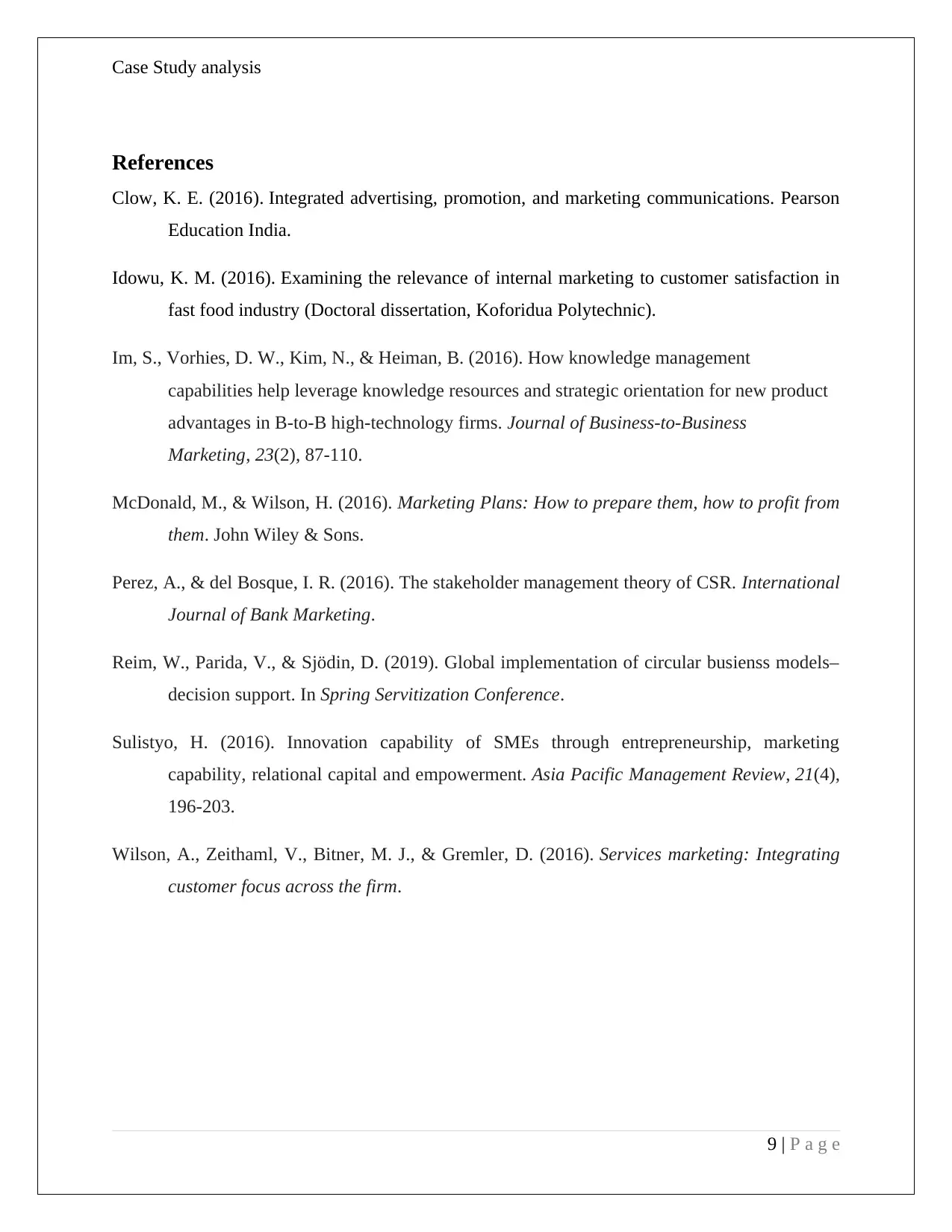
Case Study analysis
References
Clow, K. E. (2016). Integrated advertising, promotion, and marketing communications. Pearson
Education India.
Idowu, K. M. (2016). Examining the relevance of internal marketing to customer satisfaction in
fast food industry (Doctoral dissertation, Koforidua Polytechnic).
Im, S., Vorhies, D. W., Kim, N., & Heiman, B. (2016). How knowledge management
capabilities help leverage knowledge resources and strategic orientation for new product
advantages in B-to-B high-technology firms. Journal of Business-to-Business
Marketing, 23(2), 87-110.
McDonald, M., & Wilson, H. (2016). Marketing Plans: How to prepare them, how to profit from
them. John Wiley & Sons.
Perez, A., & del Bosque, I. R. (2016). The stakeholder management theory of CSR. International
Journal of Bank Marketing.
Reim, W., Parida, V., & Sjödin, D. (2019). Global implementation of circular busienss models–
decision support. In Spring Servitization Conference.
Sulistyo, H. (2016). Innovation capability of SMEs through entrepreneurship, marketing
capability, relational capital and empowerment. Asia Pacific Management Review, 21(4),
196-203.
Wilson, A., Zeithaml, V., Bitner, M. J., & Gremler, D. (2016). Services marketing: Integrating
customer focus across the firm.
9 | P a g e
References
Clow, K. E. (2016). Integrated advertising, promotion, and marketing communications. Pearson
Education India.
Idowu, K. M. (2016). Examining the relevance of internal marketing to customer satisfaction in
fast food industry (Doctoral dissertation, Koforidua Polytechnic).
Im, S., Vorhies, D. W., Kim, N., & Heiman, B. (2016). How knowledge management
capabilities help leverage knowledge resources and strategic orientation for new product
advantages in B-to-B high-technology firms. Journal of Business-to-Business
Marketing, 23(2), 87-110.
McDonald, M., & Wilson, H. (2016). Marketing Plans: How to prepare them, how to profit from
them. John Wiley & Sons.
Perez, A., & del Bosque, I. R. (2016). The stakeholder management theory of CSR. International
Journal of Bank Marketing.
Reim, W., Parida, V., & Sjödin, D. (2019). Global implementation of circular busienss models–
decision support. In Spring Servitization Conference.
Sulistyo, H. (2016). Innovation capability of SMEs through entrepreneurship, marketing
capability, relational capital and empowerment. Asia Pacific Management Review, 21(4),
196-203.
Wilson, A., Zeithaml, V., Bitner, M. J., & Gremler, D. (2016). Services marketing: Integrating
customer focus across the firm.
9 | P a g e
⊘ This is a preview!⊘
Do you want full access?
Subscribe today to unlock all pages.

Trusted by 1+ million students worldwide
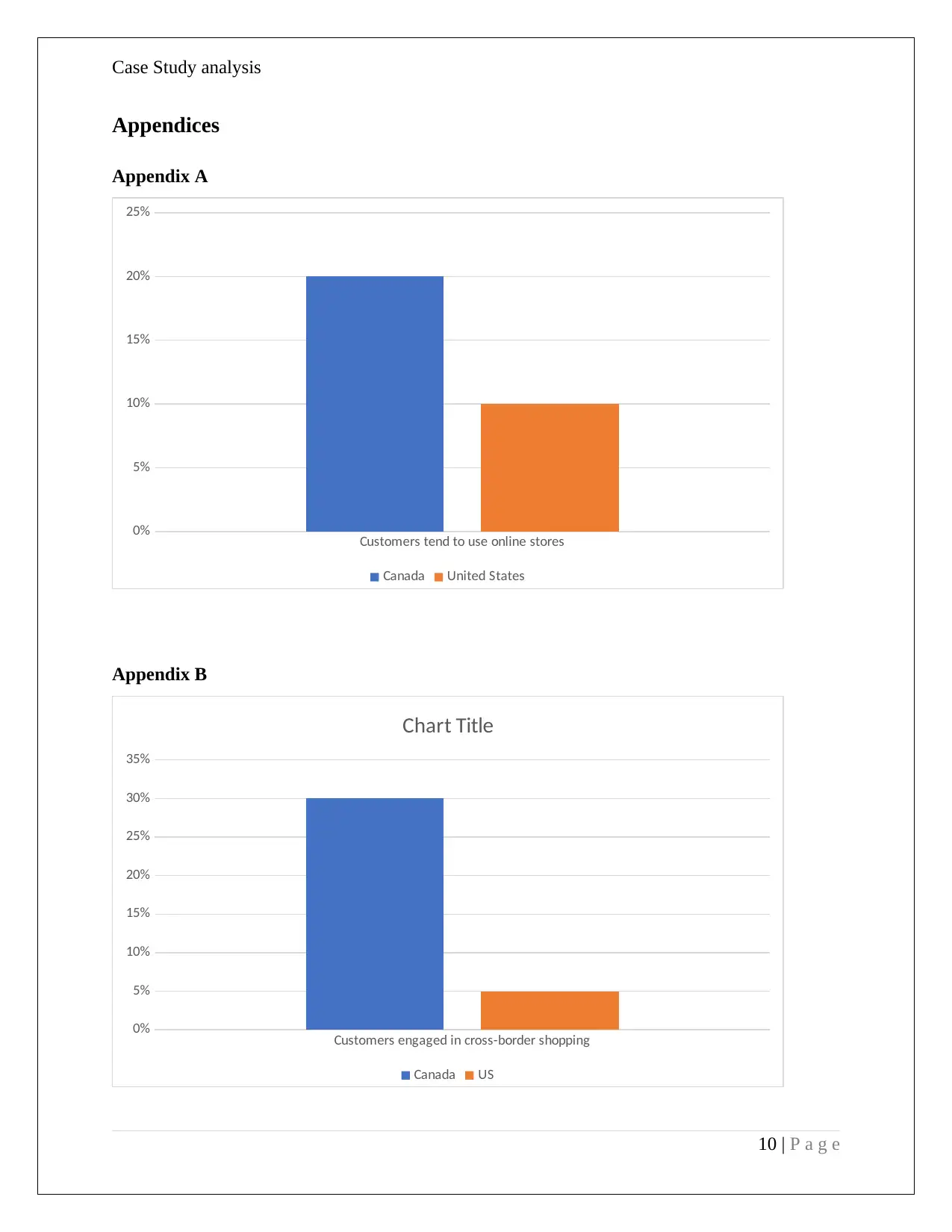
Case Study analysis
Appendices
Appendix A
Customers tend to use online stores
0%
5%
10%
15%
20%
25%
Canada United States
Appendix B
Customers engaged in cross-border shopping
0%
5%
10%
15%
20%
25%
30%
35%
Chart Title
Canada US
10 | P a g e
Appendices
Appendix A
Customers tend to use online stores
0%
5%
10%
15%
20%
25%
Canada United States
Appendix B
Customers engaged in cross-border shopping
0%
5%
10%
15%
20%
25%
30%
35%
Chart Title
Canada US
10 | P a g e
1 out of 10
Related Documents
Your All-in-One AI-Powered Toolkit for Academic Success.
+13062052269
info@desklib.com
Available 24*7 on WhatsApp / Email
![[object Object]](/_next/static/media/star-bottom.7253800d.svg)
Unlock your academic potential
Copyright © 2020–2025 A2Z Services. All Rights Reserved. Developed and managed by ZUCOL.





